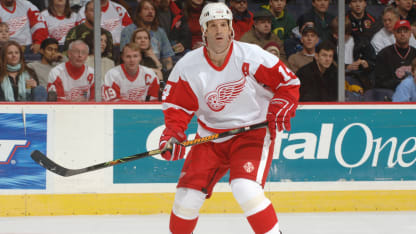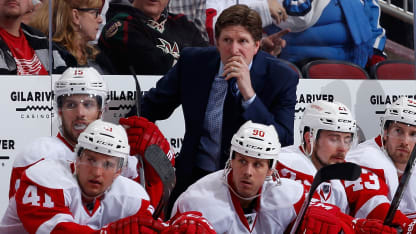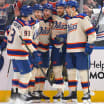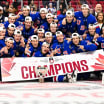TORONTO -- The president of the Toronto Maple Leafs has found himself in meetings with his organization's alumni, realizing he isn't one of them.
He's one of them.
"I'm not a Maple Leafs alumnus," Brendan Shanahan said.
No, he's a Detroit Red Wings alumnus.
Maple Leafs strive to become what Red Wings were
Brendan Shanahan, Mike Babcock carry lessons from time in Detroit

When the Maple Leafs play the Red Wings in the 2017 Rogers NHL Centennial Classic Alumni Game at Exhibition Stadium on Dec. 31, Shanahan won't skate with Wendel Clark, Doug Gilmour, Lanny McDonald, Borje Salming, Darryl Sittler or Mats Sundin. He won't wear blue and white.
He'll wear red and white with Chris Chelios, Kris Draper, Sergei Fedorov, Tomas Holmstrom, Nicklas Lidstrom, Darren McCarty, Kirk Maltby and Larry Murphy, before resuming his role with the Maple Leafs against the Red Wings for the 2017 Scotiabank NHL Centennial Classic on Jan. 1 (3 p.m. ET; NBC, SN, TVA Sports).
"It's weirder to talk about it," Shanahan said. "I think once you get around your old teammates, they're your old teammates."
This event is a celebration of the history of the NHL and the Maple Leafs in particular, and this part of it is a reminder of the influence the Red Wings have had on two men who are trying to build the Maple Leafs' future: Shanahan and coach Mike Babcock.

© Mitchell Layton/Getty Images
Each has many influences. Each faces far different challenges in Toronto. Neither wants to make the Maple Leafs an exact replica of the Red Wings.
But Shanahan spent nine seasons in Detroit as a player and won the Stanley Cup three times. Babcock spent 10 seasons there as a coach, won the Cup once and came within one victory of back-to-back championships.
They brought that with them to Toronto and have applied it in broad ways, direct ways and subtle ways most might not notice.
"What did I learn in Detroit the most?" Babcock said, leaning back in his chair in his office at the Maple Leafs' practice facility. "If you treat people right and you push them hard and you surround yourself with real good people and players, you have a chance to be happy every single day. That's what we've got to do. Now, we've got a long way to go."
The Maple Leafs are commemorating 100 years in the NHL. They have won the Stanley Cup 13 times, more than any other team but the Montreal Canadiens. But they haven't won it since 1967, the longest drought in the League, and have made the Stanley Cup Playoffs once in the past 11 seasons. They hit bottom last season when they finished last in the League standings. They won the draft lottery and used the No. 1 pick on center Auston Matthews.
It might be hard to remember now, but the Red Wings once made the playoffs once in 13 seasons from 1970-71 to 1982-83. Then they selected center Steve Yzerman No. 4 in the 1983 draft and started to rise again. They had become contenders by the time they acquired Shanahan from the Hartford Whalers on Oct. 6, 1996, but they still had not won the Stanley Cup since 1955. At that time, they had won the Cup seven times but had the longest drought in the League.
Well, they won the Cup in 1997 and '98, the last team to win it back to back, and again in 2002. They turned Detroit into "Hockeytown." So Shanahan is unafraid of droughts and doesn't care for defeatist attitudes based on them. He knows the opportunity he has in Toronto, perhaps the biggest hockey town in the world.
"Sometimes when a team hasn't won in a long time, you hear different stories -- supernatural stories -- as to why," Shanahan said. "I remember hearing them in Detroit as well, whether it's curses or bad luck or this or that. I'm a superstitious person, but I believe that if you deserve to win, no one's going to deny you.
"It's a story until you do everything you can to make it not a story."
The Red Wings won not only because they were stacked with talent but also because they were competitive, had chemistry and had the greatest coach in the history of hockey, Scotty Bowman.
Not everyone loved Bowman. But everyone knew who he was and what he had done, and they bought in or at least went along when he did things like order Yzerman to sacrifice offense, put Fedorov on defense or give others lesser roles than they were used to.
Shanahan hired the closest thing he could to Bowman on May 20, 2015: Babcock, who coached him in 2005-06, his last season in Detroit.
Babcock had learned from Bowman while Bowman was in Detroit's front office, and he had earned a reputation as the best coach in hockey not just for his work in Detroit, but for his work with Canada, including two Olympic gold medals.

© Mark Blinch/Getty Images
Players might not like what Babcock has to say all the time, but everyone knows who he is and what he has done.
"There's a credibility that goes with that with players, because a lot of times you have to ask players to do things," Shanahan said. "You need trust. Scotty had that with us. Everything he asked you to do didn't necessarily line up with everyone's individual wants. … But we trusted him.
"I think Mike has that among his players, and you need that. When you go out and have to compete and the players put themselves on the line in front of the public and the fans every night, it's a good feeling to know you can trust the guy that's behind the bench, that he's steering you the right way."
The Red Wings were an established power when Babcock arrived in 2005. They had veterans like Yzerman, Shanahan, Lidstrom, Draper and Maltby, and younger players like Pavel Datsyuk, Niklas Kronwall, and Henrik Zetterberg.
The veterans mentored the younger players, and the younger players eventually took over. The Red Wings won the Stanley Cup again in 2008 and went to Game 7 of the Final in 2009. They continued to make the playoffs every season under Babcock, and they extended their streak to 25 last season under his replacement, Jeff Blashill.

© Christian Petersen/Getty Images
"What do you take from that?" Babcock said. "There was a standard that you expect for your teams and yourself. There's a level set by Lidstrom and Yzerman and Zetterberg and Datsyuk and Kronwall of what a good pro looks like and how hard they work. And so when you see a guy's a good player, you still know whether he's a good pro or not."
The Maple Leafs were anything but an established power when Babcock arrived. They did not have anyone like Yzerman, Shanahan or Lidstrom. How does Babcock set the standard like that when he doesn't have mentors like that for Matthews, Mitch Marner, Morgan Rielly and the other young players?
"That's a great, great, great question," Babcock said.
Well, remember that Yzerman, Shanahan and Lidstrom were young once and hadn't won anything either, and they didn't have Cup winners as mentors.
"There's a whole bunch of teams that don't have it, and then they win a Cup, and then they have it," Babcock said. "So now we've got to push our people to be better."
Babcock runs training camp, practices and systems like he used to in Detroit. Especially early in his tenure, he showed the Maple Leafs video of the Red Wings to show what he wanted.
He doesn't do it as often now, forward James van Riemsdyk said, but he still does it on an individual basis. When he wanted to show Matthews how to play without the puck, he showed him video of Zetterberg and Pittsburgh Penguins captain Sidney Crosby, who has played for Babcock in international competition.
Then there are subtle things. Babcock speaks to the media like he used to in Detroit -- in the dressing room after practices for a reason, to be open, accountable, the same for everyone. When there's an empty locker, the name plate doesn't go empty. It is filled with the name of a great alumnus like Clark, Gilmour, Salming, Sittler, Sundin, Johnny Bower or Turk Broda.
"Well, that's what we did in Detroit, so that's what I'm doing here," Babcock said.
The message is obvious.
"You're playing for everybody," Babcock said. "You're tied into something that's bigger than you are."
But Babcock wants it to be more than symbolic. When he arrived in Detroit, he knew of Gordie Howe, Ted Lindsay and Alex Delvecchio, but he didn't know them as men. Over time, he got to know them, and he became particularly close with Lindsay. To the players, "Terrible Ted" became more than a black and white photo in a frame, a plaque on the wall and a name plate over an empty locker.
"He'd come in with our guys," Babcock said. "At playoff time, at the start of every series, he'd come to every meeting. He'd sit in the meeting. Oh, yeah, he was unbelievable. He'd go see the players at the morning skates. He's a really good man."
Bower, Clark and Sittler have been around the Maple Leafs. Dave Keon came in when the Maple Leafs retired his No. 14. Babcock said the Maple Leafs were trying to get Hall of Famer Red Kelly to come in.
"It would kind of be like my first couple years in Detroit," Babcock said. "You're just getting to know these people. But you're trying to get it established so they know they have a place to come and the people know who they are."
Babcock said the Maple Leafs are on "mile 10 of a 100-mile journey." They're just getting started. But he can envision the ending because he has seen it before.

© Bill Wippert/Getty Images
"Ideally, someone will look at this franchise and say, 'Jeez, they've just made the playoffs 10 years in a row and they've got a chance to win the Cup all the time,'" Babcock said.
"This is no knock on Detroit, [but] the people in this city are crazy for hockey. Like, it's unbelievable. It's like nothing you've ever seen in your life. And so it's important that we build a franchise that is worthy of our logo and our city and what it represents.
"The Red Wings, let's be honest: Twenty-five years in a row in the playoffs, the only team since the lockout to make the playoffs every single year, that's a special, special thing. It's a hard thing to do, and they've managed to do it. And what they've done is, they've had lots of good people come and go through their organization, and they develop players and people and have been a fantastic thing, and so we'd like to do the same thing.
"We're going to become like Detroit was, and that's our goal."

















